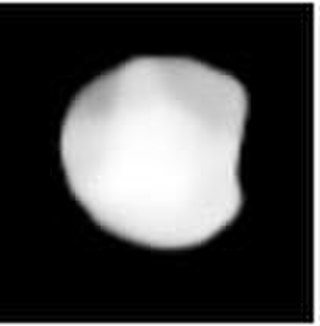173 Ino
From Wikipedia, the free encyclopedia
173 Ino is a large asteroid and the parent body of the Ino family, located in the central regions of the asteroid belt, approximately 150 kilometers (93 miles) in diameter. It was discovered on 1 August 1877, by French astronomer Alphonse Borrelly at Marseille Observatory in southern France, and named after the queen Ino from Greek mythology.[1][3] The dark Xk-type asteroid has a rotation period of 6.15 hours.[21]
 | |
| Discovery[1] | |
|---|---|
| Discovered by | A. Borrelly |
| Discovery site | Marseille |
| Discovery date | 1 August 1877 |
| Designations | |
| (173) Ino | |
| Pronunciation | /ˈaɪnoʊ/ EYE-noh[2] |
Named after | Ἰνώ Īnṓ[3] (Greek mythology) |
| A877 PA; 1922 SB | |
| main-belt[1][4] · (middle) Ino[5] | |
| Adjectives | Inoan (/aɪˈnoʊən/ eye-NOH-ən)[6] |
| Orbital characteristics[4] | |
| Epoch 23 March 2018 (JD 2458200.5) | |
| Uncertainty parameter 0 | |
| Observation arc | 138.75 yr (50,678 d) |
| Aphelion | 3.3142 AU |
| Perihelion | 2.1708 AU |
| 2.7425 AU | |
| Eccentricity | 0.2085 |
| 4.54 yr (1,659 d) | |
| 307.27° | |
| 0° 13m 1.2s / day | |
| Inclination | 14.197° |
| 148.18° | |
| 228.89° | |
| Physical characteristics | |
| 145±3 km[7] 119±27 km[8] 125.8±1.5 km[9] 148±42 km[10] 154.1±3.5 km[11] 160.6 km[12] | |
| Flattening | 0.24[a] |
| Mass | (2.2±1.3)×1018 kg[7] (4.79±3.11)×1018 kg[13] |
Mean density | 1.4±0.8 g/cm3[7] 2.23±1.47 g/cm3[13] |
| 5.93 h[14] 6.1±0.2 h[15] 6.106±0.001 h[15] 6.1088±0.0007 h[15] 6.11 h[16] 6.113±0.002 h[17] 6.11651 h[18] 6.15 h[19][4] 6.163 h[20] | |
| 0.061 (calculated)[7] 0.059[12] 0.06±0.02[10] 0.0642±0.003[11] 0.07±0.05[8] 0.096±0.018[9][4] | |
| Tholen = C[4] SMASS = Xk[4] B–V = 0.705[4] U–B = 0.305[4] | |
| 7.66[9][10][11][12][21] 7.99[4] 7.80±0.05[22] 7.90[8][23] | |
Orbit and classification
Ino is the parent body and namesake of the Ino family (522),[5] an asteroid family in the intermediate main belt with nearly 500 known members.[24]: 23 The adjectival form of the asteroid name is "Inoan".
It orbits the Sun in the central main-belt at a distance of 2.2–3.3 AU once every 4 years and 6 months (1,659 days; semi-major axis of 2.74 AU). Its orbit has an eccentricity of 0.21 and an inclination of 14° with respect to the ecliptic.[4] The body's observation arc begins at Düsseldorf-Bilk Observatory in January 1879, five months after its official discovery observation at Marseilles.[1]
Physical characteristics
In the Tholen classification, Ino is a common carbonaceous C-type, while in the SMASS classification it is a Xk-subtype that transitions between the X-type and uncommon K-type asteroids.[4]
Multiple photometric studies of this asteroid were performed between 1978 and 2002. The combined data gave an irregular, asymmetrical light curve with a period of 6.163 ± 0.005 hours and a brightness variation of 0.10–0.15 in magnitude. The asteroid is rotating in a retrograde direction.[18]
Notes
- Flattening derived from the maximum aspect ratio (c/a): , where (c/a) = 0.76±0.06.[7]
References
External links
Wikiwand - on
Seamless Wikipedia browsing. On steroids.

